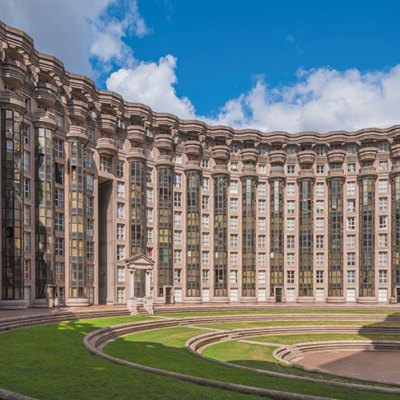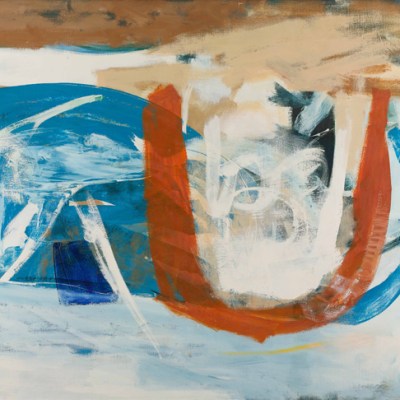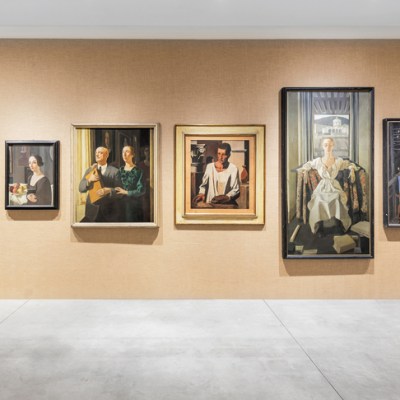In 1929, a letter from F. T Marinetti changed the course of Tullio Crali’s life forever. ‘Dear Futurist, delighted to have you with us in the Futurist struggle,’ it read. As Crali later recounted: ‘I read and re-read it [with a mixture of] incredulity, immense joy, pride, responsibility.’
The adolescent, self-taught artist growing up in Zadar hurried to tell his mother, assumed his place among the Futurists ‘in a state of excitement that I would not experience again until my wedding day’, and never looked back. He had been experimenting with the style since he was 15 years old and would remain devoted to it for the rest of his life. A year after getting the nod from the Italian movement’s leader, Crali had produced The Forces of the Bend (1930), a wheel-spinning exemplar of Futurist painting as polished as the sleek red racing car it depicts hurtling in a long, loud rush of colour past the viewer.
The Forces of the Bend (1930), Tullio Crali

This painting now opens ‘Tullio Crali: A Futurist Life’ at the Estorick Collection, the first solo exhibition of Crali’s art to be held outside Italy since his death in 2000. Featuring little-known pieces from his family’s collection, the display spans his entire career and grapples with the consistencies, contradictions and complications inherent in the work of a man who championed Futurism long after most had abandoned it.
Crali joined the Futurists at a moment when aeropittura (art celebrating flight) was gaining momentum, and it was in this area that he would make his name. He had a remarkable capacity for translating the power and drama of flight into paint. Early works such as Lights at Sunset in Ostia (1930) – a joyous picture in which delicate clouds and tall arches of light rise above the blue sea on the horizon – lay the groundwork for later masterpieces such as Magic in Flight (1968), which combines the same elements to different dramatic effect. Its uplifting diagonals and wheeling curves convey a sense of speed and motion; simplified, map-like details suggest the viewer’s dizzying distance from the earth; and amid it all hovers a pale orb of light, refracted off the clouds or sea below, the type of surreal observed detail that only a true flying enthusiast would notice and think to paint.
Magic in Flight (1968), Tullio Crali

These works give powerful visual expression to the exhilaration Crali experienced whenever he was in the air, ‘the surprise of feeling oneself suspended at one hundred, five hundred, a thousand metres above the ocean’. Others dwell on a more destructive side of aeronautics. Crali’s enthusiasm for militarised flight is apparent throughout his career – from Aerial Duel of 1929 to his celebration of the Frecce Tricolori, Italy’s version of the Red Arrows, from 1986 – and his talent for painting the subject both made and compromised his reputation. A decade after he joined the Futurists, the world was tipped into total war. As aeroplanes took to the skies to destroy cities and devastate communities, Crali made some of his most celebrated works as a war artist in Mussolini’s Italy. He is known today almost exclusively for wartime paintings such as Nose-diving on the City (1939; not in this show), and yet because of the uncomfortably close association between Futurism and Fascism during this period, his art does not often get an outing.
All this is acknowledged directly in the exhibition, but it is clear that the curators want to move beyond it. Crali, they argue, was a Futurist in spirit, not in politics; a supporter of modernity, science and technology with little time for the ideologies of either the left or right. ‘Futurism is not a political party that one can join and leave according to one’s whims,’ the artist, who was infuriated when the group faltered and fractured in the war’s aftermath, declared decades later. ‘Ideals cannot simply be tossed aside. I despise politics; I love poetry. I cannot change who I am.’ Only a couple of his characteristic wartime works feature, with space reserved instead for other, less well-known experiments. Among the aeroplanes of the post-war years, we encounter Crali’s cats, resting in Piedmont in 1948; busy industrial ports (Port Structures (Nantes), 1954); quiet Parisian streets (Place Fustenberger (Paris), 1958); and a surreal figurative fantasy, Falling into Infinity, from 1986. In all these paintings Crali deftly modifies his Futurist style to suit his subjects. The cats bristle with subdued energy, the port paintings are varnished smooth to match their metal subjects, while Paris assumes a painterly, cubist look in the dim light of its street lamps.
The Eruption (1977), Tullio Crali

The most interesting revelations here are the works that range furthest stylistically from the famous planes. Two sketchbooks – one from the years Crali spent in Paris in the 1950s, another from his time in Cairo the following decade – capture snatches of everyday urban life with an assured, economical, gently meandering line that is in striking contrast to his dynamic paintings. Upstairs, much room is given over to his Sassintesi, a series of sculptural wall pieces made of rocks, stones, and other geological debris. These foraged items are carefully assembled against empty grounds and given cryptic titles such as Discussion about Dogma (1975) and The First Day (1979). At first, they seem incongruous. Why would an avowed Futurist, obsessed with speed and machines, turn his attention to the slow formation and erosion of the earth? But seen in the light of the Sassintesi, Crali’s post-war aeropaintings take on a subtly different aspect. The polished surfaces and clean lines of his 1930s works become grittier and craggy-edged after the war. Mountains, rather than cities, loom into the pilot’s view. Man’s mechanical forces become conflated with much greater, elemental ones.
Almost lost among the Sassintesi are a few small paintings on cardboard of ‘cosmic’ views from the space race era. They are deceptively modest, their marbled surfaces hinting only vaguely at the scale and significance of what they depict. But in a cabinet nearby can be found Crali’s Orbital Art manifesto from 1969, which envisages how mankind might paint the sky new colours and turn asteroids into art. It is preposterous and yet, as we consider sucking carbon out of the atmosphere to stop a climate crisis of our own making, also not. Is Crali celebrating mankind’s power, or its poetry? The best of the works here beg the question with their compelling, contradictory mixture of lyricism and bombast.
Tricolour Wings (1932), Tullio Crali

‘Tullio Crali: A Futurist Life’ is at the Estorick Collection, London, until 11 April.



